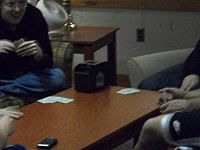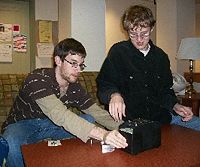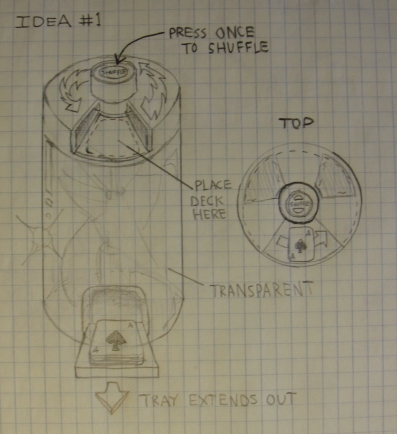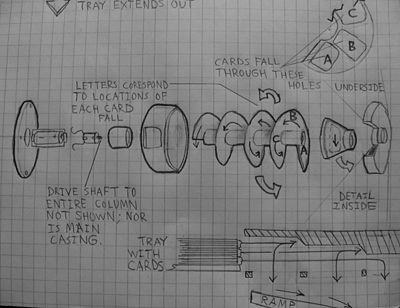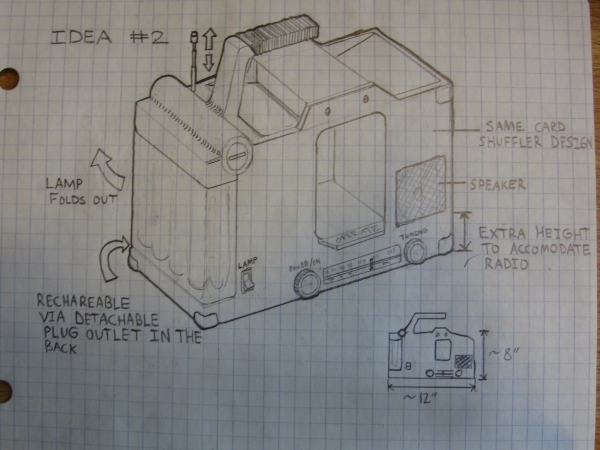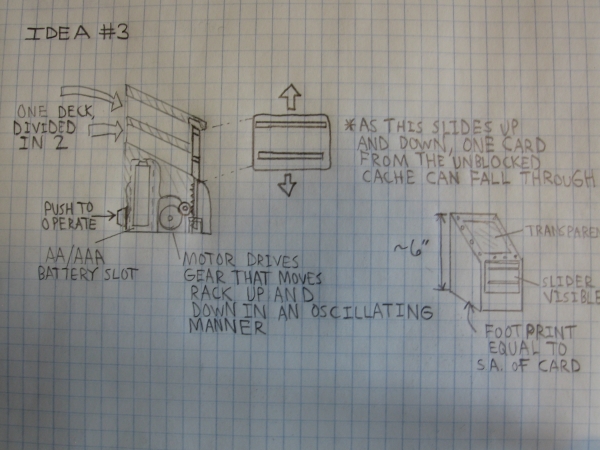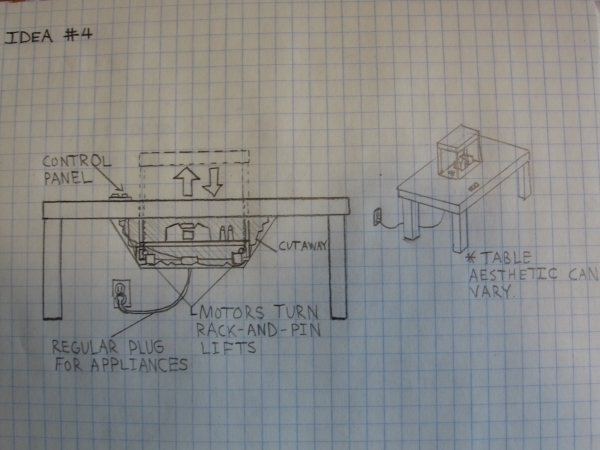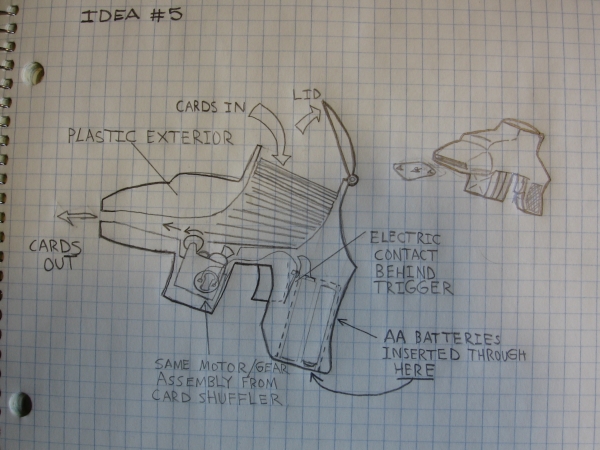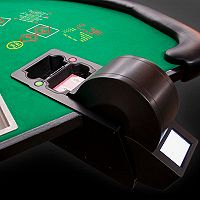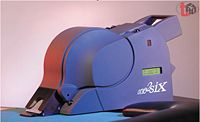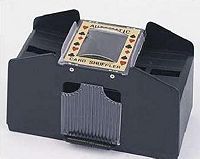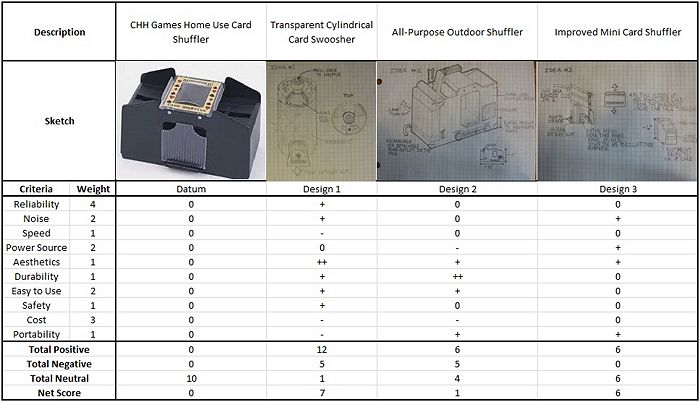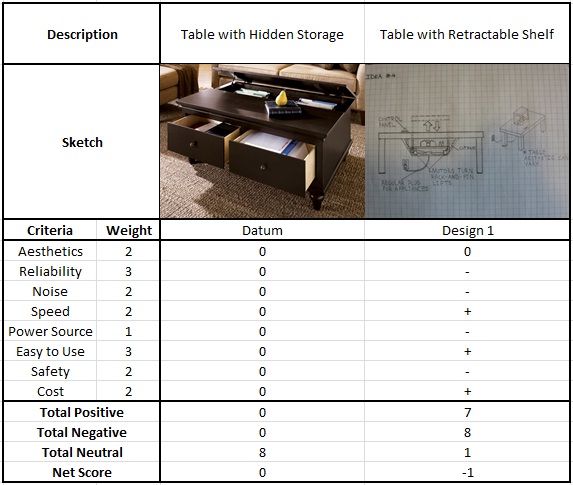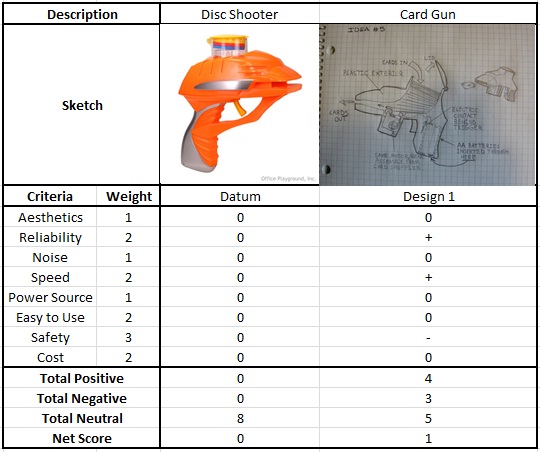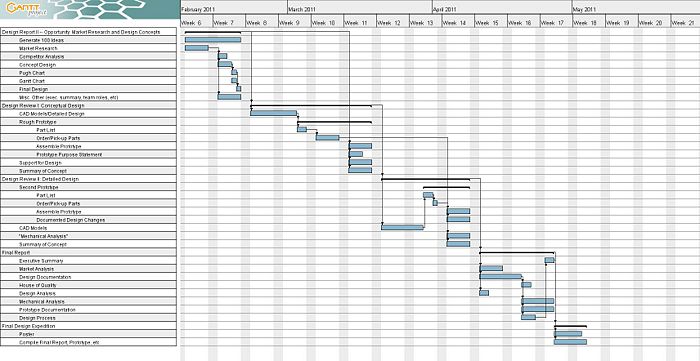Automatic card shuffler opportunity
From DDL Wiki
Contents |
Report 2: Opportunity - Market Research and Design Concepts
Executive Summary
Market research was conducted related to automatic card shufflers to determine the types of improvements in which users would be interested. The four main types of market research that were done were online product reviews, anthropological study, user interviews, and expert interviews. The information from each was collected and analyzed to determine what problems/areas for improvement came up most frequently.
The decision was made to focus more on the home use market because of the very high-tech and complex solutions with high functionality that can be found in casinos. From that point, several sessions of brainstorming and idea generation occurred to determine how best to attack the problems with the current home use technology and to make new innovations that would appeal toward the potential users.
From the large list of ideas, 5 main ideas emerged, three involving improvements to card shufflers and the other two as auxiliary ideas that stemmed from our market research. The latter two involved an improved card table with hidden storage and a card gun. After analysis, the two auxiliary ideas were discarded due to the fact that they do not represent a significant advance in technology, if any.
Of the remaining ideas, two card shuffler designs stood out on our Pugh Chart analysis: the transparent, cylindrical card swoosher and an improved mini card shuffler. Each design is targeted toward a different market, but each address needs that were present in our market research. After discussion, we are recommending pursuing the transparent card swoosher design because its unique design will encourage users to continue using the product after their initial enthusiasm has died down. Also, it has lower power requirements as compared to the current home use model, which goes along nicely with our Design for Environment findings.
Market Research
To further understand the stakeholder needs for the card shuffling device, we conducted several market research studies, including an analysis of the online reviews for the product, anthropological study, user/customer interviews and expert interviews at the Rivers Casino.
Online User Reviews
The online user reviews reflected many of the problems that we detected during our initial analysis and dissection. Consumers seem disappointed with the quality and effectiveness of the device. It was reported to look cheap and of bad quality. Many users reported that the device had broken pieces or was defective right out of the box. While we did not experience this, it seems as though we narrowly avoided it. Many complained that cards would get stuck vertically on the inner walls of the device and/or that cards were frequently flipped face-up. Some of the reviewers mentioned these problems, but also admitted that they did not expect much more from the device considering the price. There were also complaints of the noise. A few customers were disappointed that the device only accommodated standard sized cards. Lastly, there were many complaints about the lack of directions included with the device.
Anthropological Study
We observed while a group of five Carnegie Mellon students played a card game. We gave them the shuffler with the instructions to treat it as if it had just been received as a gift. The game lasted about an hour and took place on the CMU campus. What we saw during this study followed very closely with our own initial impressions of the device following Report 1. There seemed to be some initial excitement to use the device, but after its inconsistent performance, it was pushed to the side of the game and ignored. The following were our main findings:
- Noise: When the students shuffled their cards for the first time, there was a huge reaction from each of them to the noise, and the person pressing the shuffling button immediately stopped from shock. During its use throughout the game, it was impossible for their conversation to continue and sentences had to be repeated.
- Lack of instructions: When first inspecting the device, the students had more difficulty than we expected figuring out how it worked. They made comments about the lack of instruction manual.
- Aesthetics: Many of the students made comments about the "chintzy" or cheap look of the device.
- Inconsistency: From the very first shuffle, the deck was being shuffled unevenly, cards were being flipped face up and cards were getting stuck in the machine. There were many comments regarding the unfortunate inconsistency of the device. We noticed that most of the time, the students shuffled the deck a few times after using the device, displaying a lack of confidence with its performance.
- Redesign ideas: Interesting improvements were suggested during the game, many of which we had been considering already. We noticed that no one wanted to keep score or deal during the game. Adding these features to the device would increase its appeal. It was mentioned that although the device was advertised on the box as being an "Automatic Card Shuffler" it was not actually automatic and it would be cool if the device was voice-activated. The idea of transparency also came up and was reacted to positively.
User Interviews
After conducting the anthropological study, we had each of the players answer the following questions:
Card Shuffler
- How often do you play card games?
- When you play card games do they often use more than one deck of cards? How many?
- Why do you enjoy playing card games?
- Did you find the card shuffling device helpful? Please comment.
- What were the best aspects of the card shuffling device?
- What were the worst aspects of the card shuffling device?
- What improvements would you make to the card shuffling device?
- How much would you be willing to pay for a card shuffler?
Card Organizer
- Would you find a device that does this process for you helpful? Please comment.
- What features would you find important with this sort of device?
- What features would you find unnecessary with this device?
- Would you prefer to buy this “card-organizing” device or a card shuffling device?
- How much would you be willing to pay for the card-organizing device? What if it could also shuffle your cards?
Once again we found that the responses from users to go along with our initial findings. Most of the users reported playing cards about 2-3 times per week. Users reported disappointment with the device and said that it did not add anything to the game. The most common complaint was that it flipped cards face up during shuffling and was therefore ineffective and unreliable. Several people also mentioned that because it required splitting the deck of cards in half to feed them through the shuffler, it actually took more time to use the shuffler than to shuffle by hand. There were also comments about wasted time trying to figure out how to use the device and about the shockingly loud noise during operation of the device.
Expert Interviews
We went to the Rivers Casino in downtown Pittsburgh and interviewed several of the dealers that worked there. They use automatic card shufflers every day in a professional setting. We also walked around and observed the card shufflers in action. The types we saw in the casino were very different from the product that we dissected. They also came in a variety of brands, sizes and shapes.
Main Discoveries
- Card Organizing/Sorting Function -- The first important discovery that we made is that the devices used in casinos can indeed separate decks of cards post game play. Not only this, but the shufflers sort the cards in numerical order as they do this. This function seems incredibly useful for packing away the cards and/or devices at the end of game play (though many casinos are open 24/7, including the one in Pittsburgh).
- Silent -- The card shuffling devices used in the casino were practically silent compared to the device we dissected. Perhaps the music, conversation volume and general noise of the casino also contributed to our perception of this, but the main point here is that the volume of the devices did not interfere with game play or conversation during game play.
- Ease of Use -- There were several features of the devices we observed in the casinos that caused them to be easier to use than the device we dissected. One feature that was universal between the different shufflers in the casino is that they all had a single intake feed for the cards. This is different from the shuffler that we dissected, which required splitting a single deck in two halves or putting different decks on different sides of the device. The shuffler in the casino also accommodated different sized cards with this single feed. Having a single intake feed greatly increases the speed of the overall shuffling process and makes the device much easier for a dealer to use. Another excellent feature universal between the devices was that there was a glowing green button that only had to be pressed once to start the shuffling process and a glowing red button next to it that stopped the shuffling process. Even with more complicated machines that dealt the cards for the dealer (explained below), these two buttons were present.
- Dealing Function -- Some of the devices were able to deal cards to the players. They were able to correctly do this, no matter the number or position of the players. The shuffler could also handle dealing the dealer's hand differently than the hands of the players. The shuffler could correctly deal for games such as Texas Hold 'Em, where there are universal cards face-up in the center of the table.
- Built-in Devices -- Most of the shufflers in the casino were built into the card tables themselves. This was a very helpful feature as it kept the device from interfering with game play, yet had the device placed such that it was in a convenient position for the dealer to use. Not having to deal with moving the device back and forth increased the ease of the shuffling process.
- Jam Detection -- The casino dealers admitted that the machines did jam from time to time, but there seemed to be an efficient system in place for fixing these issues. In addition to this, many of the shufflers had self-evaluating sensors that would report to the dealers if there were any expected or current problems with the devices. For instance, if a gear was beginning to wiggle off track, the devices had a way of reporting this, enabling the casino to catch problems before they became more difficult to deal with. This process seemed very helpful in ensuring smooth flow of game play.
None of the casino employees that were interviewed (including managers) were able to estimate a price per device, but all expected that the individual machines were expensive. The machines in the casino were clearly much more high-tech, having much more functionality and more professional performance that the device that we dissected. Our observation of these devices sparked many ideas for our own design concepts. The most notable discovery was that having a single intake feed for the cards significantly increases the overall user experience with the device, as it increases the ease of use of the device and the speed of the shuffling process. We also had the idea that as the shuffler organized decks of cards, it would be a great function for it to be able to discover missing cards and report which were missing.
Overall we discovered that the devices used in casinos are already quite developed, yet there is a gap in the market for an at home device that performs some of the same functions as the casino shufflers and performs to a higher standard that the at home devices available on the market now.
Design Concepts
Through our findings in both the market research and idea generation stages, we have identified several design ideas that we would be interested in pursuing. Each of the designs has been thought of with a different market or stakeholder in mind. While we do feel that each of these ideas represents an advancement, they do not come without drawbacks as compared to current technology and products. At this stage, though, each of the designs will be explained in detail and what needs they address in regards to their target users.
Transparent Cylindrical Card "Swoosher"
The "Swoosher" shuffles cards in a lackadaisical fashion. The deck is placed on the exposed section of a rotating disk. When the "Shuffle" button is pressed and released, the disk funnels the card deck into the cavity that is actually the start of a down-ramp slide. At three different locations along the inside of the top casing (shown at the far right in Figure 6), obstructions force the single card deck to fall away into holes that lead to the spiraling ramp below. Thus, the cards are all thrown to the mercy of gravity at different points. To prevent impairments due to card clotting, the central corkscrew spiral also rotates. The cards eventually all slide to the bottom, where they are pushed back into one stack by the swirling motion of the spiraling corkscrew. Once the user notices all the cards have fallen through, another simple push of the button is required to stop the device. The cards can then be easily removed from the collection cavity.
All-Purpose Outdoor Shuffler
The Outdoor Shuffler is geared towards children (Boy or Girl Scouts, for example) who venture often into the wilderness for both vacations and troop nights. Powered by a rechargeable, non-removable battery, this concept contains three key outdoor entertainment features: a fluorescent lamp, an AM/FM radio, and a 2-deck card shuffler. All are contained in a water-proof, durable plastic casing that holds all three items. A handle extends out from the top for easy transport in general and specifically for aiming the lamp about on a dark and spooky night. The antenna for the radio is retractable, and all buttons are large and clearly labeled for use. The card shuffler is essentially the same mechanism inside as the competitor model that was studied in Report 1.
Improved Mini Card Shuffler
The miniature card shuffler is an extreme novelty item. Able to be held in the palm of one's hand, it can only accept one deck of cards at a time and runs on a single motor and rack-and-pinion assembly. A single AA or 2 AAA batteries can power this device while a button must be pressed by the user to maintain an electrical contact between the battery and the motor. The cards themselves, positioned at a 45-degree angle inside their slots, are blocked by a sliding vertical panel that is attached to the moving vertical rack. The panel contains two narrow slits that can allow one card through each. As the panel slides up, the bottom slit is blocked and the cards in the lower chamber do not move while one card from the top chamber is allowed to fall through. The opposite scenario occurs when the panel is lowered. In a rapid series of oscillations, the cards sift through and accumulate in a pile before the mini-shuffler.
Table with Retractable Shelf
The table with a motorized, retractable shelf looks no different than an ordinary coffee table found in a living room or dormitory lounge. However, the outline of a rectangle in the center of the tabletop hints at its true innovation. In a recessed cavity, a set of four motors attached to sliding rods via a rack-and-pinion system provide power to lift a small shelf upon which anything can be stored out of sight. Be it a card shuffler, a condiment rack, or a surprise gift, the central lift can bring any small item into accessibility really quickly, and with the press of a button, tuck it out of sight. Like a home appliance, it can be plugged into a wall outlet for electrical power.
Card Gun
Based on foam disk shooters, the card gun takes one of the motor assemblies from the competitor product and uses it as a motive force to propel playing cards as projectiles within a stylized firearm body made of plastic not unlike toy guns made by NERF. It is likely the cards in this case will be packaged with the gun to provide instant-use gratification to the user (likely children between the ages of 6 and 12).
Competitor Products
After conducting both web and patent searches, we have identified two main types of competing products: casino-style shufflers and home use shufflers. Additionally, we were able to identify two main types of casino shufflers after our visit to the Rivers Casino in downtown Pittsburgh: the One2six Shuffler and the iDeal Shuffler, both produced by Shuffle Master. These types of shufflers are very advanced and have a lot of built-in capabilities, such as micro-processors that can analyze how well the shuffler is doing at actually randomizing the deck. In addition to shuffling the cards, these machines can "unshuffle" the decks by splitting them back into individual decks and organizing them numerically according to suit. We have decided to not focus our efforts into this market because of the high level of complexity that already exists within this market. Although no one at the casino knew how much these shufflers cost, we were able to do a search and found that the iDeal Shuffler retails for approximately $23,000, which is a little out of our price range.
The other main area of competing products consists of home use shufflers. While these shufflers do vary slightly from model to model, the same main mechanical ideas come into play with all of the shufflers. In almost all of the shufflers, the deck is split in two, with each half deck placed on a different side of the shuffler. From that point, a button on the bottom of the shuffler is pressed, which initiates the motor that pushes the cards one by one into the center slot where the cards are collected. An example of a shuffler fitting this description would be the 4-Deck Casino Style Automatic Card Shuffler produced by CHH Imports that we analyzed during the dissection phase. We believe that there are areas for improvement within this area of shufflers to create a more enjoyable user atmosphere while adding additional features. Our goal is to make a new type of shuffler that is at least comparable in price to the current shufflers or potentially a little bit more expensive, but hopefully users will be willing to pay the little bit extra to due to the new features and overall card shuffler experience.
Pugh Charts
Card Shufflers
The first area of our ideas that we analyzed was card shufflers. We set the current standard as the 4-Deck Casino Style Automatic Card Shuffler produced by CHH Imports, which was the product that we previously analyzed and dissected. The analysis criteria and weighting system were based on the most common results of our market research. For this sector, it was very obvious that the main issue was the reliability of the shuffle. For that reason, this criteria was given the highest weighting factor. Cost was a very close second, however, because many users told us that they would only buy a shuffler if it were cheap. From these comparisons, two ideas began to stand out: the Transparent Cylindrical Card "Swoosher" and the Improved Mini Card Shuffler.
The Transparent Cylindrical Card "Swoosher" scored rather well according to the Pugh chart. We believe that our new design will produce a more reliable shuffle than the current model, which is a major advantage that our product will have. Also, the ability for the user to see the cards circling through the product will hopefully produce an enjoyable experience and deal with the problem of users getting bored with the device and simply shuffling by hand. Also, we hope to reduce the amount of noise and ease of use by using this unique card shuffling technique. This innovation does not come without drawbacks though. The major obstacle that this product will face is that it will most likely be slightly more expensive than current models. This will create an obstacle for gaining customers, especially when shuffling by hand is an alternative. Another drawback is that it will be bigger than the current model. This will cause problems for taking up more space for shipping as well as storage within the home. Finally, the lower battery power and the mechanism that actually shuffles the cards will combine to make the overall shuffle slower than current models. This product would be targeted more towards the novelty market, because it will be slightly more expensive than the current market. Families with small children may be drawn toward this product because it is safer to operate plus more fun for children to watch the cards swirl downward toward the bottom. The simplicity of operation and novelty may also make this appealing for the elderly with arthritic pains and for use in nursing homes.
The Improved Mini Card Shuffler also scored well as compared to the current technology. This design also includes a new mechanism for shuffling the cards, as previously discussed in the Design Concepts section, and we are not sure about the reliability. This could potentially be a major selling point or a major failure in terms of the design, so we must reserve judgment until an actual prototype is made. The smaller size will greatly help in regards to shipping and storage because it will be able to stack very easily. While it was considered neutral in durability compared to the datum, the current model was not very durable to start with, so this would most likely be a problem for this product as well. While making the product smaller would seem to lend itself to a lower price, the parts would need to be made with greater precision, which will lead to more problems in terms of manufacturing. This product would be targeted towards people who value their space and don’t have a lot of room to be taken up by a card shuffler. This product could be ideal for home use card games around a table, because it can be moved to the side very easily and won’t take up a lot of space.
The final design is the All-Purpose Outdoor Shuffler. This product would be a much more durable product than currently exists to deal with the elements. As this product would need to be used outdoors, portability is important, and we feel that this design would address that need. A major downside is that the shuffling mechanism would be almost identical to the current technology, which does not produce a very reliable shuffle. Since this is one of our major concerns moving forward, the fact that this design does not really address that issue is problematic. The large size and the contributions of the lamp and radio would necessitate a larger power source, most likely meaning more batteries. This is a problem because one of the main considerations from our Design for Environment was that the batteries produced the largest environmental impact. This product would be targeted towards people who like to be outdoors and go camping. Families with children who are involved in activities such as Boy Scouts or Girl Scouts could take advantage of such a product. Also, people who simply want to play outside on their decks or porch could be potential users for this product.
Hidden Storage Tables
The next section that we analyzed was the idea of the table with a retractable shelf for hidden storage. To provide a basis for comparison, we found a table that includes several hidden storage locations, but they must open manually. The particular table that we found also retails for close to $1,000, but that can vary depending on the quality of the table. Our new design would address some of the issues with the current table, but falls short in many other areas. Firstly, the speed at which the shelf could reveal itself is much faster in our new design, as it is electronically operated as opposed to manual. This would also increase the ease of use, because the person does not have to physically lift anything to reveal the hidden storage. One major drawback of this design is that, due to its mechanical nature, there are bound to be some failures. This is a major disadvantage over the current model because in that situation there is almost no possibility of failure. Another disadvantage is that the new model would be much noisier than the original, which is one of our main concerns. After analysis, this design measured up almost equivalent to the current model and didn’t represent that large of a jump in technology.
Disc Guns
The final section that we analyzed was the idea of a card gun. As a datum, we used a toy gun that shoots small foam discs. This product functions fairly similarly to the design concept that we had, with the only noticeable difference being that our gun shoots cards instead of foam discs. An advantage of our card gun design is that it will appeal to kids who have watched the X-Men movies and want to emulate one of the characters, Gambit. We also feel that our new design will be able to produce a more rapid fire as compared to the disc shooter simply due to the nature of the objects being shot. Our main concern in this sector, however, is safety, and this is where our new design falls way behind our competitor. Foam discs are soft and don’t generally hurt, no matter how they hit their intended target. Playing cards, however, have hard, sharp edges which could potentially be dangerous, especially if they are shot at high speeds. This is one of the main reasons that despite some advantages, this product doesn’t really represent advancement over the current technology.
Gantt Chart
A Gantt Chart was created using a software called Gantt Project. The duration of the tasks left to complete this semester were estimated as accurately as possible, taking into account due dates and deadlines from the course syllabus.
Team Member Roles
- Alexander Harber -- Main Design Concept Generator/Illustrator, User Scenario Author, Market Research (product reviews online)
- Alana Yoel -- Market Research Lead, Gantt Chart Creator, Idea Contributor
- Paul Wagner -- Executive Summary, Competitor Analysis, Pugh Charts
- Tanvi Bubna -- Idea generation, market research (casino trip), PowerPoint
Conclusions
Based on the market research conducted, we are inclined to proceed with the novel "Card Swoosher" concept. With its transparent casing and series of spiraling slides visible to the user, it overwhelmingly bests the competitor product in terms of aesthetics and quality. The reliance on one motor to initiate the cards' movement and its reduced battery usage also makes it more environmentally friendly in concordance with the earlier DFE results from Report 1. The major downside include the cost, as it will be much more expensive both to produce and for the user to purchase. However, we consider the concept's high novelty appeal and distinct look to be a strong argument for potential users to spend a good additional amount of money on.
The following is a hypothetical user scenario:
Bryan Smith-Johnson is a 25 year-old newly-wed. He and his wife are simple folk who are easily intrigued by novel gadgets such as the iPhone, Nintendo Wii, and Dyson vacuum. On nights when they feel too tired to go out, Bryan and his wife like to play card games and occasionally invite neighbors to join them. Wanting to both impress their friends and find a simple way to shuffle cards, they turned to the Swoosh Daddy 2000. With its single motor and gravity-assisted spiral slides, the Smith-Johnsons and their esteemed guests are never interrupted mid-conversation by loud mechanical noise. And with the transparent casing, all are amazed by the thrilling display of cards sailing amongst one another through the slides inside the machine. With the press of a single button, the cards are swept into the device, the motor powered by a single battery. With all these neat features, the Swoosh Daddy 2000 will make the Smith-Johnsons the talk of Suburbia for years to come!
Appendix A: List of 100 Design Ideas
Card Shuffling Ideas/Improvements
- 1. Cylindrical “Coin Bank” Casing
- 2. Single-press Button
- 3. Rounded Edges and Curves on the Casing
- 4. “Face-changing” cards
- 5. Removable, micro-thin, card faces (including dispensing machine that can take off the micro-film)
- 6. Water-wheel shuffling mechanism (for novelty)
- 7. Steam-powered “retro” card shuffler casing and mechanism (for novelty)
- 8. Built-in music or song playback device, or funny voices
- 9. Microprocessor control for card shuffling action
- 10. Throwable design
- 11. Zero-gravity-friendly design (for astronauts on the I.S.S.)
- 12. Electronic scorekeeper/ranking list addition
- 13. Upload link to global rankings or score-list server
- 14. Card acrobatics – a separate mechanism for “playing” with discarded cards during game play
- 15. Actually make mechanism automatic/hands free (maybe touch sensor activated by weight of cards)
- 16. Voice activated (respond to a name)
- 17. Single deck feed
- 18. Adapt shuffler so it is able to shuffle other objects (candy, marbles, etc)*
Card Re-organizer
- 19. Vision sensor for card recognition
- 20. Child safety lock
- 21. Face-down card orientating mechanism (makes sure cards all face the same way prior to organizing)*
- 22. Have machine put cards in numerical order as it separates the decks
- 23. Keep track of exact cards in each sorted pile so that even decks with the same pattern can be sorted
Other/Cross-applicable Ideas
- 24. Unique styling/colorings (interchangeable?)
- 25. Transparent Casing
- 26. Solitary power source for both motors
- 27. Rubber-grip base and edges over entire device
- 28. Built-in lamp light for use during household power outage or outdoors at night
- 29. Commercial-use light accents/decoration (identify with casino/gambling image)
- 30. Offline game database for rules, suggestions, instructions, and safety warnings
- 31. “Swiss Army Knife” additions – cup holder, poker chip holder, bottle opener, etc.
- 32. Wasp saliva “paper” – an environmentally-friendly alternative to plastic for the casing
- 33. Metal gear solid system
- 34. iPod/music player dock with built-in speaker
- 35. Power outlet cord power option (retractable)
- 36. Wi-Fi connection for restaurant/casino/lounge location search
- 37. Waterproof exterior (hide exposed gears or mechanisms)
- 38. Built-in Breathalyzer (to prevent guests from leaving the game night to drive under the influence)
- 39. Include paper instruction manual/safety guide
- 40. Have device deal cards too (some kind of lazy Susan-ish mechanism), can input number of players and number of cards per person
- 41. While shuffling or reorganizing, device would notice missing cards in the deck and which ones
- 42. Automatic/non-removable card dispensing tray
- 43. New kind of table that had slot for/was incorporated with card shuffler/snacks/etc (built-in)
- 44. Fun facts about cards, card games, etc pop-up after each round of shuffling
- 45. Built in air freshener
- 46. Wheels with stoppers/locks to facilitate moving device out of the way after use or passing between players
- 47. Built-in ashtray and lighter
- 48. Build-in AM/FM radio or Satellite/XM radio
- 49. Bulletproof
- 50. Collapsible/Foldable for easier storage
- 51. Fireproof—add a layer of fireproof material from fireman suits, also adds softness
- 52. Include safe to keep your gambling money safe, hidden and separate from other money
- 53. Built-in fan in case of hot weather or outdoor use
- 54. If no automatic score keeping, built-in pencil sharpener and many sticky notes for scorekeeping
- 55. Able to handle different sized playing cards
- 56. Speed controlled shuffler
- 57. Light to indicate low battery
- 58. Self-monitoring shuffler (will alert you if gears become misaligned or other problems come up)—like when printer alerts about being out of paper.
- 59. Include large clock
- 60. Remote controlled shuffler
- 61. Built-in “banker” –gives out poker chips in exchange for money, gives change, etc
- 62. Hand sanitizer
- 63. Less noisy in shuffling mechanism
- 64. Robotic arms to deal cards (feel like you are in a casino with a dealer
- 65. Can set max bet in shuffler and if on any given night that bet is exceeded, will automatically call 1-800-GAMBLER
- 66. Solar powered (links to solar panel on roof of home)
- 67. More environmentally friendly plastic
- 68. Use AA or AAA batteries exclusively (no C cells)
- 69. Buzzer to alert player that s/he has been gone from the table too long and his/her spot will be given away soon
- 70. Glowing buttons for operation of device
- 71. Money-ironer to fix crinkly bills
- 72. Call alert for waitress or manager
- 73. At end of game have shuffler evaluate player’s gambling tendencies and announce
- 74. GPS navigation to help you find you way around in a casino
- 75. Anti-corrosive metallic parts
- 76. Lego card shuffler – aesthetically interesting
- 77. Can take cards of different sizes
- 78. Air-spin mechanism for shuffling/organizing
- 79. Dome-shaped card-shuffler/organizer
- 80. Stack divisibility possible
- 81. Resistant to extreme temperatures
- 82. Easy assembly - can be disassembled to reduce storage space
- 83. Wheels at the bottom– easily moved on the table
- 84. Spring system to pop up the cards once they are shuffled/organized
- 85. Includes an automated dice-rolling mechanism
- 86. A chip projector attached to it
- 87. Transparent device with opaque bottoms
- 88. Change machine attached
- 89. Mobile-phone holders attached
- 90. Automatic die roller
- 91. Scissor mechanism for standard shuffling
- 92. Musical shuffler
- 93. Touch screen interface
- 94. Unbend any bent corners of the card
- 95. Computerized – video tutorials on different games
- 96. Hand crank – manual operation to control speed
- 97. A shoot to stack it before shuffling
- 98. Card counter – tells you if you are missing a card
- 99. A protective filter to make sure nothing apart from cards enter the slot
- 100. Shaped like the different suits of the deck
References
- "CHH Imports 4 Deck Card Shuffler." Amazon.com. Web. 17 Feb. 2011. <http://www.amazon.com/CHH-Imports-Deck-Card-Shuffler/dp/B0009HMOGM>.
- "Disc Shooter - Fire Shot Automatic." Office Playground. Web. 17 Feb. 2011. <http://www.officeplayground.com/Disc-Shooter-Fire-Shot-Automatic-P622.aspx>.
- "Handy Cocktail Table with Hidden Storage and Two Drawers." THEFURNITURE.COM. Web. 17 Feb. 2011. <http://www.thefurniture.com/store/proddetail.asp?prod=KINCAID-SOMERSET-CTABLE-46-024>.
- "Las Vegas News, Hotels, Casinos and Best Deals." Vegasbuzz.com. Web. 17 Feb. 2011. <http://vegasbuzz.com/page/29/>.
- "Shuffle Master ONE2SIX." thetpro.com. Web. 17 Feb. 2011. <http://www.thetpro.com/shuffle-machine-one2six.htm>.
- "TMF: iDeal the Real Deal / Shuffle Master." The Motley Fool. Web. 19 Feb. 2011. <http://boards.fool.com/ideal-the-real-deal-26625114.aspx?sort=username>.

